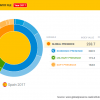Summary
This paper is the result of a joint project by the Istituto Affari Internazionali (Rome) and the Elcano Royal Institute, promoted by the Italian Embassy in Madrid. It provides a broad view of the evolution of Spanish and Italian external migration policies through a closer examination of their approach towards the Sahel region and in light of the broader EU policy context. The analysis focuses on the historical background, migratory contexts, policy tools, perspectives, interests and strategic preferences of these two key EU Member States. Its aim is to encourage an improved and broadened dialogue between the two countries, ultimately contributing to increased cooperation on external migration policies.
Introduction
Being located at the external borders of the EU, Italy and Spain face similar challenges in managing migration originating from and transiting through Africa. The patterns and magnitude of the migration flows along the Central Mediterranean Route (CMR) –of primary concern to Italy– and along the Western Mediterranean (WMR) and Atlantic Routes (WAR) –of foremost concern for Spain– vary over time and exhibit certain differences. Nevertheless, both countries are interested in relieving migratory pressure through cooperation with origin and transit countries and encouraging the development of coherent and complementary policies at the EU level. Despite similar geostrategic realities and shared challenges, cooperation in the external dimension of migration management between the two countries has so far remained limited.
Migratory pressure on the EU in general, and the EU Member States (EUMS) at its external borders in particular, has been mounting from 2014-15 onwards, gradually leading to a relatively better realisation of the structural, complex and multi-dimensional nature of EU-bound migration. This has highlighted the importance of a comprehensive and concerted approach that not only links migration with action in development, security and the broader scope of foreign policy, but also combines the efforts and assets of EUMS with those of the EU as a whole. The achievement of higher degrees of complementarity and coherence nevertheless remains a challenge. The recent move towards an integrated approach in external migration management has already led to improved communication and increased degrees of operational cooperation between EUMS, as well as between Italy and Spain in and vis-à-vis countries of origin and transit of common concern. This can offer a window of opportunity for broadening and improving cooperation and for developing functioning mechanisms of communication and coordination between the two countries.
The Sahel is a highly relevant region for better understanding the Italian and Spanish approaches to external migration management, examining the workings of the current collaboration between the two, and exploring future venues for enhanced cooperation. This is the case not only because the Sahel is highly prioritised by both countries but also because it has become one of the main ‘laboratories’ of EUMS cooperation with the recently augmented activism within the EU framework. The Sahel is also a region that shows up the complex inter-linkages between migration and demographic dynamics, socioeconomic development, human and state (in)security, and political instability, all aspects which partnership mechanisms with third countries should take into account.
Carmen González Enríquez (Elcano Royal Institute), Patrícia Lisa (Elcano Royal Institute), Asli Selin Okyay (IAI), Anja Palm (IAI)
The authors would like to thank the Italian Embassy in Madrid for its support in their research and Nicoletta Pirozzi (IAI) and Bernardo Venturi (IAI) for their valuable contributions and feedback to the previous versions of this paper. They are also particularly indebted to all those interviewed and to the Spanish, Italian and EU authorities for their time, generosity and sharing of knowledge.
Migration routes from West Africa to Europe. Map: historicair / Wikimedia Commons (CC BY-SA 3.0)




